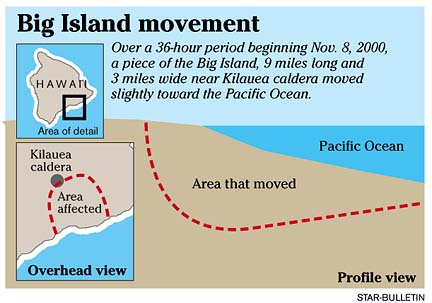

Slow land shift HILO >> Toward the end of 2000, a huge piece of the Big Island, 9 miles long and 3 miles wide, slumped toward the Pacific.
observed on Kilauea
Scientists describe a massive
earth slump in November 2000By Rod Thompson
rthompson@starbulletin.comIt could have produced an earthquake measuring 5.7 on the Richter scale, but it didn't even make a jiggle.
In fact, the only way scientists knew something happened was by checking satellite-linked global positioning system monitors.
What does it mean when a piece of land the size of Honolulu from the airport to Diamond Head moves and almost no one notices? That's what scientists at the Hawaiian Volcano Observatory are trying to figure out.

The event took place over a 36-hour period beginning Nov. 8, 2000, said geophysicist Peter Cervelli, the lead author of a Feb. 28 Nature magazine article on the event.The site was the Hilina Pali area of Hawaii Volcanoes National Park south of Kilauea caldera.
This kind of thing has been seen before in other parts of the world, but this was the first time it was seen while it was happening, said Don Swanson, scientist-in-charge of the obser- vatory.
Scientists call it an "aseismic" event, meaning no shaking, no earthquake. But if the same massive chunk of land had moved in five seconds instead of 36 hours, it would have produced a 5.7 earthquake, Cervelli said.
The real movement was deep, 2 1/2 miles below ground level, traveling an estimated 3 1/2 inches. Movement on the surface was just 1 inch.
Why did it happen? Cervelli thinks maybe, just maybe, the massive rainfall of Nov. 1-2, 2000, triggered it.
The theory is that the ground is full of old rainwater all the time. The weight of the added rainfall sent a slow pressure wave downward that opened up and lubricated a horizontal fault line, allowing the slow, smooth, short-distance sliding of rock.
So it was smooth this time, what about next time? In 1975 the same area slid 11 feet, producing a 7.2 earthquake and a tsunami that killed two people.
Some observers have even linked the Nov. 8 slump to 17 "catastrophic" prehistoric Hawaii earthquakes that occurred roughly once every 300,000 years. One more than a million years ago literally broke off Windward Oahu, sending debris a hundred miles out to sea, creating Nuuanu Pali and Kaneohe Bay.
Cervelli said there is no certainty about how the Nov. 8 "aseismic" event relates to those "catastrophic" quakes. One theory is that the quakeless slumping relieves pressure and helps to prevent big quakes, he said.
Swanson said slumping without earthquakes is "probably just normal activity for Kilauea."